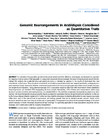Genomic Rearrangements in Arabidopsis Considered as Quantitative Traits
dc.contributor.author
Imprialou, Martha
dc.contributor.author
Kahles, André
dc.contributor.author
Steffen, Joshua G.
dc.contributor.author
Osborne, Edward J.
dc.contributor.author
Gan, Xiangchao
dc.contributor.author
Lempe, Janne
dc.contributor.author
Bhomra, Amarjit
dc.contributor.author
Belfield, Eric
dc.contributor.author
Visscher, Anne
dc.contributor.author
Greenhalgh, Robert
dc.contributor.author
Harberd, Nicholas P.
dc.contributor.author
Goram, Richard
dc.contributor.author
Hein, Jotun
dc.contributor.author
Robert-Seilaniantz, Alexandre
dc.contributor.author
Jones, Jonathan
dc.contributor.author
Stegle, Oliver
dc.contributor.author
Kover, Paula
dc.contributor.author
Tsiantis, Miltos
dc.contributor.author
Nordborg, Magnus
dc.contributor.author
Rätsch, Gunnar
dc.contributor.author
Clark, Richard M.
dc.contributor.author
Mott, Richard
dc.date.accessioned
2019-12-16T17:33:22Z
dc.date.available
2017-10-06T03:47:17Z
dc.date.available
2017-11-13T15:56:05Z
dc.date.available
2019-12-16T17:33:22Z
dc.date.issued
2017-04
dc.identifier.issn
1943-2631
dc.identifier.other
10.1534/genetics.116.192823
en_US
dc.identifier.uri
http://hdl.handle.net/20.500.11850/191854
dc.identifier.doi
10.3929/ethz-b-000191854
dc.description.abstract
To understand the population genetics of structural variants and their effects on phenotypes, we developed an approach to mapping structural variants that segregate in a population sequenced at low coverage. We avoid calling structural variants directly. Instead, the evidence for a potential structural variant at a locus is indicated by variation in the counts of short-reads that map anomalously to that locus. These structural variant traits are treated as quantitative traits and mapped genetically, analogously to a gene expression study. Association between a structural variant trait at one locus, and genotypes at a distant locus indicate the origin and target of a transposition. Using ultra-low-coverage (0.3×) population sequence data from 488 recombinant inbred Arabidopsis thaliana genomes, we identified 6502 segregating structural variants. Remarkably, 25% of these were transpositions. While many structural variants cannot be delineated precisely, we validated 83% of 44 predicted transposition breakpoints by polymerase chain reaction. We show that specific structural variants may be causative for quantitative trait loci for germination and resistance to infection by the fungus Albugo laibachii, isolate Nc14. Further we show that the phenotypic heritability attributable to read-mapping anomalies differs from, and, in the case of time to germination and bolting, exceeds that due to standard genetic variation. Genes within structural variants are also more likely to be silenced or dysregulated. This approach complements the prevalent strategy of structural variant discovery in fewer individuals sequenced at high coverage. It is generally applicable to large populations sequenced at low-coverage, and is particularly suited to mapping transpositions.
en_US
dc.format
application/pdf
en_US
dc.language.iso
en
en_US
dc.publisher
Genetics Society of America
en_US
dc.rights.uri
http://creativecommons.org/licenses/by/4.0/
dc.subject
structural variation
en_US
dc.subject
Arabidopsis
en_US
dc.subject
quantitative trait locus
en_US
dc.subject
heritability
en_US
dc.subject
low-coverage sequencing
en_US
dc.title
Genomic Rearrangements in Arabidopsis Considered as Quantitative Traits
en_US
dc.type
Journal Article
dc.rights.license
Creative Commons Attribution 4.0 International
dc.date.published
2017-03-30
ethz.journal.title
Genetics
ethz.journal.volume
205
en_US
ethz.journal.issue
4
en_US
ethz.pages.start
1425
en_US
ethz.pages.end
1441
en_US
ethz.version.deposit
publishedVersion
en_US
ethz.identifier.wos
ethz.identifier.scopus
ethz.publication.place
Bethesda, MD
en_US
ethz.publication.status
published
en_US
ethz.leitzahl
ETH Zürich::00002 - ETH Zürich::00012 - Lehre und Forschung::00007 - Departemente::02150 - Dep. Informatik / Dep. of Computer Science::02661 - Institut für Maschinelles Lernen / Institute for Machine Learning::09568 - Rätsch, Gunnar / Rätsch, Gunnar
en_US
ethz.leitzahl
ETH Zürich::00002 - ETH Zürich::00012 - Lehre und Forschung::00007 - Departemente::02150 - Dep. Informatik / Dep. of Computer Science::02661 - Institut für Maschinelles Lernen / Institute for Machine Learning::09568 - Rätsch, Gunnar / Rätsch, Gunnar
en_US
ethz.leitzahl.certified
ETH Zürich::00002 - ETH Zürich::00012 - Lehre und Forschung::00007 - Departemente::02150 - Dep. Informatik / Dep. of Computer Science::02661 - Institut für Maschinelles Lernen / Institute for Machine Learning::09568 - Rätsch, Gunnar / Rätsch, Gunnar
ethz.leitzahl.certified
ETH Zürich::00002 - ETH Zürich::00012 - Lehre und Forschung::00007 - Departemente::02150 - Dep. Informatik / Dep. of Computer Science::02661 - Institut für Maschinelles Lernen / Institute for Machine Learning::09568 - Rätsch, Gunnar / Rätsch, Gunnar
ethz.date.deposited
2017-10-06T03:47:36Z
ethz.source
WOS
ethz.eth
yes
en_US
ethz.availability
Open access
en_US
ethz.rosetta.installDate
2017-11-13T15:56:14Z
ethz.rosetta.lastUpdated
2023-02-06T17:58:20Z
ethz.rosetta.versionExported
true
ethz.COinS
ctx_ver=Z39.88-2004&rft_val_fmt=info:ofi/fmt:kev:mtx:journal&rft.atitle=Genomic%20Rearrangements%20in%20Arabidopsis%20Considered%20as%20Quantitative%20Traits&rft.jtitle=Genetics&rft.date=2017-04&rft.volume=205&rft.issue=4&rft.spage=1425&rft.epage=1441&rft.issn=1943-2631&rft.au=Imprialou,%20Martha&Kahles,%20Andr%C3%A9&Steffen,%20Joshua%20G.&Osborne,%20Edward%20J.&Gan,%20Xiangchao&rft.genre=article&rft_id=info:doi/10.1534/genetics.116.192823&
Files in this item
Publication type
-
Journal Article [128858]

